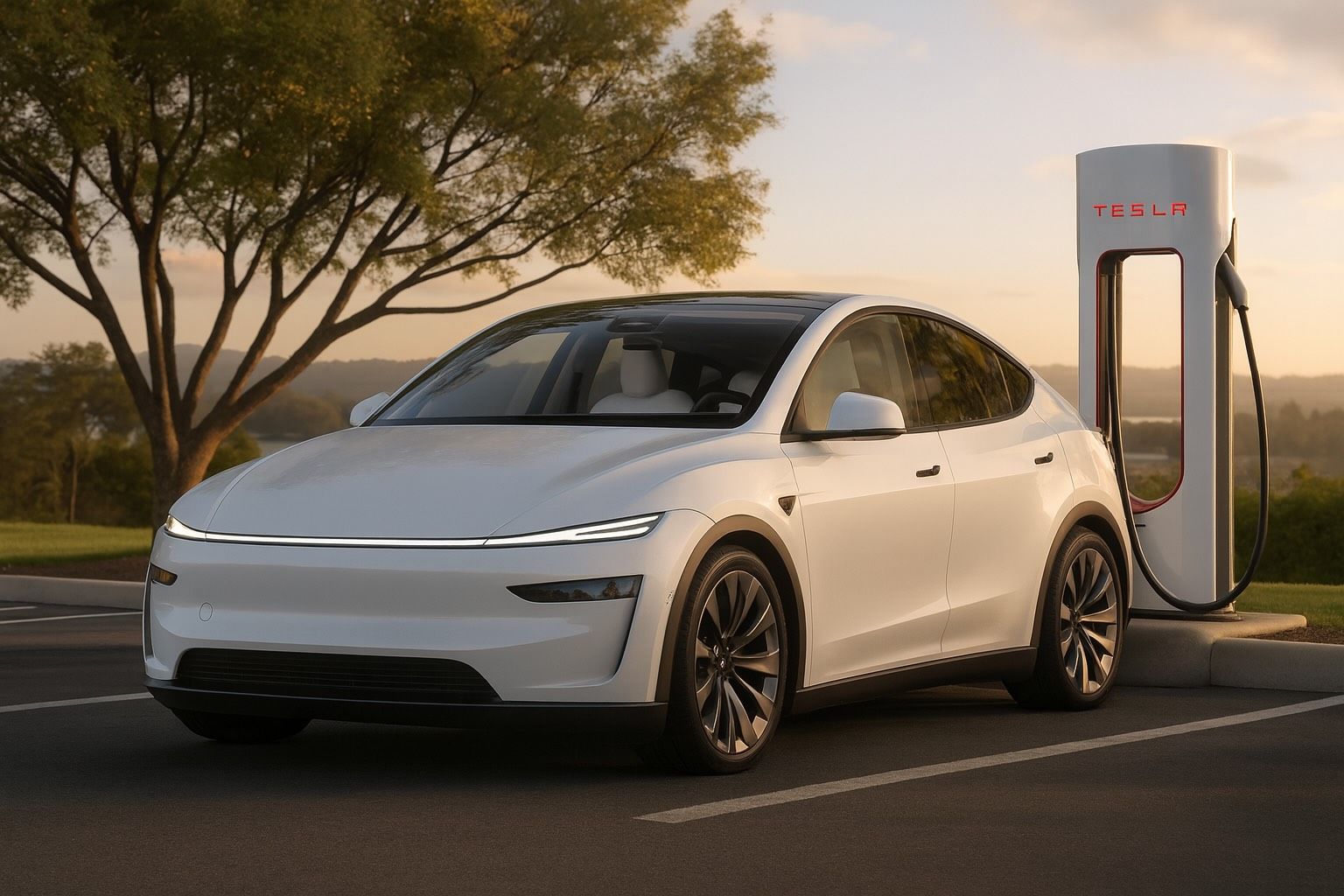- Tesla’s Mixed Signals: Tesla posted record Q3 deliveries (~497,000) but profit missed estimates, as rising costs squeezed margins [1]. TSLA slid ~4% after earnings and now trades around $460 per share [2] [3], up about 9% year-to-date – lagging the broader market.
- Ford & GM Rally on Earnings:Ford blew past Q3 forecasts (EPS $0.45 vs $0.35 expected) [4], while General Motorsraised its profit outlook for 2025, citing easing tariff costs and smaller EV losses [5]. Ford’s stock jumped ~5% and GM surged 15% – its best day in years [6] – as investors cheered the legacy automakers’ resilience.
- BYD’s Boom Cooling: China’s EV champion BYD saw its first sales drop in over five years (Q3 sales fell 2.1% YoY) [7]. The company slashed its 2025 target from 5.5 million to 4.6 million vehicles [8] amid a fierce price war, as Beijing signals it will end EV subsidies going forward [9]. BYD’s Hong Kong–listed shares trade near HK$105 (≈$13.5).
- EV Startups Struggle:Rivian is cutting ~600 jobs (4% of staff) as EV demand slumps post-subsidy [10]. It also trimmed its delivery forecast and now only expects to break even on gross profit next year [11] [12]. RIVN stock hovers at $13–14 (down ~43% in 2025) [13] [14], and analysts like Mizuho’s Vijay Rakesh warn of “slowing EV demand” ahead [15].
- Traditional Giants Holding Firm:Toyota shares just hit a 52-week high (~$209 [16]) as the world’s largest automaker benefits from robust sales of hybrids and SUVs. Toyota’s September production jumped 11% YoY [17]. Legacy carmakers are funding EV investments with profits from gasoline models [18], even as they cautiously scale back EV plans amid softer demand.
Market Snapshot: Automakers See Volatility Amid Mixed News
Automaker stocks are on a rollercoaster this week as investors digest third-quarter earnings and shifting trends in the car industry. As of Oct. 29, major car stocks are showing divergent moves. On Wall Street, Tesla (TSLA) is trading around $460 per share [19] after a post-earnings pullback, while Ford (F) hovers in the mid-$12 range after a late-week surge [20]. General Motors (GM) is holding near multi-month highs following its big rally on an upward forecast revision [21]. In Asia, BYD in Hong Kong is around HK$105 (≈$13.5) after a recent slide [22], and Japan’s Toyota (TM) just closed above $209 on the NYSE, a fresh 12-month peak [23]. Overall, auto stocks are responding sharply to earnings surprises, policy changes, and the evolving electric vehicle (EV) outlook.
Broadly, market sentiment is bifurcated: traditional automakers’ shares have climbed on better-than-feared results, while pure EV makers are under pressure. The S&P 500 is up modestly this month, but auto sector performance is mixed, with EV-focused stocks lagging. Investors are also eyeing macro factors – a Federal Reserve meeting and global economic data – which could influence interest rates and car demand. In the background, oil prices and government incentives (or the lack thereof) are adding further cross-currents for the auto industry. All told, the car stock sector is at an inflection point, balancing short-term challenges against long-term bets on electrification.
Tesla: Record Sales But Profit Pressures Mount
Tesla remains the bellwether of EV stocks, and its latest results gave bulls and bears alike something to chew on. In Q3 2025, Tesla’s revenue hit a record $28.1 billion, fueled by an all-time high in vehicle deliveries [24]. Sales were turbocharged by a last-minute rush before a U.S. EV tax credit expired on Sept. 30, helping Tesla hand over 497,000 vehicles in the quarter [25] – far above Wall Street’s estimates [26]. CEO Elon Musk noted that “people don’t have enough money… so the more affordable we can make the car, the better,” as Tesla aggressively cut prices to stoke demand [27].
However, cracks are showing in Tesla’s margins. The company’s profit fell short of expectations despite the sales record [28]. On the earnings call, Tesla revealed that rising costs – including about $400 million in new import tariffs – dented its bottom line [29]. Highly profitable regulatory credit sales also declined, further pressuring profits [30]. As a result, Tesla’s streak of quarterly profit misses stretched to four [31]. “The margin compression is the real concern,” said eToro analyst Farhan Badami, noting that higher operating expenses, increased tariffs and lower credit revenue all hit at once [32]. Tesla’s stock sank about 4.4% after the earnings release [33], underscoring those concerns.
Investor reaction to Tesla’s recent strategic moves has been lukewarm. In early October, Tesla unveiled new “Standard Range” versions of the Model Y and Model 3 – essentially cheaper trims around $36–40k [34]. Musk pitched them as “affordable” Teslas for a broader market [35]. But when details emerged that the price cuts were only ~$5,000 and came with feature trade-offs, markets were underwhelmed. Tesla’s stock initially jumped into the mid-$450s ahead of the announcement, then slid 4% on a classic “buy the rumor, sell the news” reaction [36] [37]. Even longtime Tesla bull Dan Ives of Wedbush admitted he was “disappointed” the new models weren’t cheaper [38], calling the move “a pricing lever, not a product catalyst” unlikely to dramatically expand Tesla’s market [39]. Many analysts argue Tesla “needs a sub-$30k EV” to truly tap mass-market demand long-term [40].
Despite short-term headwinds, Tesla’s valuation and vision remain sky-high. The stock is up roughly 9% in 2025 (versus ~17% for the S&P 500) [41], and at ~$460/share it trades at an eye-watering >200× earnings [42]. Bulls like Morgan Stanley and Piper Sandler have recently lifted their price targets into the $400–$500s [43], arguing that Tesla’s lead in EV technology, software, and even emerging areas like robotics will justify a premium. Musk has been hyping Tesla’s forays into AI and autonomous driving – from a pilot robotaxi fleet in Austin to the humanoid Optimus robot project [44] – as the next frontiers. Those ambitions, however, are still on the horizon. In the near term, Tesla faces a potential Q4 sales dip now that U.S. buyers no longer have a $7,500 incentive to push them into showrooms [45]. The company and its investors are anxiously watching if recent price cuts can keep volumes growing without crushing profit margins further. As one strategist put it, Tesla is trying to “balance near-term growth… with long-term innovation” – a “tricky but potentially rewarding” path [46].
Detroit’s Legacy Automakers: Earnings Surprises and Strategic Shifts
Traditional automakers have delivered upside surprises this earnings season, even as they grapple with EV uncertainty. Ford Motor Co. posted a strong Q3 beat, reassuring investors about its core business. The Michigan-based maker of F-150s earned $0.45 per share last quarter (well above consensus of $0.35) on revenue of $47.2 billion [47]. Robust sales of its gasoline pickups and SUVs – which jumped 8% in the U.S. as drivers snapped up F-Series trucks and Bronco SUVs – powered Ford’s results [48]. These high-margin models are effectively “funding the EV transition” for Ford [49], providing cash flow that the company is using to invest in electrification (and to continue paying a hefty ~5% dividend to shareholders [50]).
Investors sent Ford’s stock up after the earnings news – shares popped about 4% in after-hours trading on Oct. 23 [51] and have been trending higher since. Year-to-date, Ford stock is still up roughly 20–25% [52], outpacing many peers thanks to optimism earlier in 2025. However, Ford isn’t entirely in the clear. The company trimmed its full-year profit outlook due to unforeseen challenges [53]. Notably, a fire at a key supplier (an Ohio aluminum plant making F-150 parts) will shave an estimated $0.5–1.0 billion off Ford’s earnings [54]. Ford now sees 2025 EBIT of $6.0–6.5 billion, down from a prior $6.5–7.5B [55], although management noted that absent the fire, they would have guided over $8B – underscoring the one-off nature of that hit [56]. CEO Jim Farley also struck a cautious tone on EVs, warning that the loss of U.S. tax credits could cut EV sales in half (from ~10% of the market down to ~5%) without adjustments [57]. Ford has already responded by dialing back some EV investments and delaying certain new electric models to control costs [58]. In Farley’s words, Ford is “effectively funding the electric pivot with our profitable [gas] business” – and will proceed “as the market dictates” on EV expansion [59].
General Motors, meanwhile, delivered one of its biggest stock pops in decades after astonishing the market with an upbeat forecast. On Oct. 21, GM not only reported solid results but hiked its annual profit outlook – a rare move in today’s climate [60] [61]. The automaker now expects $12–13 billion in 2025 core earnings (adjusted EBIT), up from a prior $10–12.5B range [62]. CEO Mary Barra credited “relief on two fronts”: lower tariff costs than feared and “lighter losses on electric cars” as GM retools its EV strategy [63] [64]. In fact, GM disclosed it took a $1.6 billion write-down this quarter to unwind some of its EV investments [65] – essentially acknowledging that “near-term EV adoption will be lower than planned,” as Barra candidly stated [66]. With the U.S. EV tax credit gone and emissions rules being relaxed by the current administration, GM is tapping the brakes on aggressive EV expansion. “By acting swiftly… to address overcapacity, we expect to reduce EV losses in 2026 and beyond,” Barra told shareholders [67].
Wall Street rewarded GM’s pragmatism: GM shares rocketed 15% in one day [68], their largest one-day gain since 2017. The stock jump – which put GM around $37, the highest in over a year – also lifted other auto stocks. Crosstown rival Ford climbed ~5% in sympathy, and even Stellantis (maker of Jeep and Chrysler) saw its U.S.-listed shares rise ~4% [69]. The message: Detroit’s incumbents are navigating the EV transition more cautiously, which investors see as realism rather than pessimism. GM’s underlying Q3 numbers were solid too: adjusted EPS of $2.80 beat forecasts (vs $2.31 expected) [70], even though revenue was flat from a year ago amid supply chain hiccups. American consumers are still buying cars – U.S. auto sales rose ~6% last quarter [71] – and crucially, they’re opting for high-end trims and options when they do [72]. That has helped automakers maintain earnings despite tariff costs and inflation. Indeed, new U.S. government measures are offsetting some pain: President Trump approved credits for domestic production that effectively rebate 3.75% of a vehicle’s price to counter import tariffs [73]. This policy change is expected to save U.S. carmakers billions and was another factor in GM’s rosier outlook.
Toyota, the world’s largest automaker, is also quietly thriving in the current environment. Toyota’s stock hit a new 12-month high this week, topping $209 on the NYSE [74], after climbing ~6% in the past week alone [75]. The Japanese giant has been buoyed by strong demand in North America and a rebound from past supply issues. Toyota announced its global output rose 11% year-on-year in September – the fourth consecutive monthly increase [76]. In the U.S., production leapt nearly 30% as Toyota cranked out more hybrids and SUVs to meet booming demand [77]. This solid performance comes even as Toyota has been slower to embrace pure EVs than its competitors. Ironically, that caution is paying off in the short term: with EV sales cooling, Toyota’s focus on efficient gasoline hybrids (like its popular RAV4 and Camry hybrids) is keeping sales and profits steady. Analysts note Toyota is trading at just ~10× earnings – a fraction of Tesla’s valuation – and has attracted some upgrades in recent weeks [78]. While Toyota did miss earnings estimates in its last report (due to higher costs) [79], investors appear to be looking past that. The company’s conservative approach (and massive scale of 10+ million vehicles a year) provide a stability that the market currently favors.
Elsewhere among legacy carmakers, the landscape is mixed. German automakers have faced headwinds – for instance, Mercedes-Benz saw its net profit plunge 50% this year, hurt by tariffs and a China slump [80] [81]. Yet even Mercedes’ stock skyrocketed 5–6% after its earnings, as results weren’t as bad as feared [82]. That rally, with Mercedes near a 52-week high, shows how low expectations had sunk for old-guard auto firms. Investors seem relieved if these companies can simply navigate the storm without major surprises. From Detroit to Tokyo to Stuttgart, traditional automakers are emphasizing cost cuts, core strengths, and cautious EV rollouts. Ford and GM, for example, are paring back EV spending and capacity – Ford is delaying a second electric truck plant, and GM is reportedly reevaluating its EV lineup – aiming to match the reality of today’s demand. At the same time, they continue to invest in the next generation of vehicles, just at a more measured pace. “We’re funding our future with today’s profits,” is a common refrain. So far, that strategy is earning nods from the market, as evidenced by the recent stock surges.
EV Startups & Pure-Plays: Hard Times After the Hype
In contrast to the incumbents, EV-focused automakers and startups are finding 2025 to be a tough slog. Companies that a year or two ago were market darlings are now scrambling to cut costs and convince investors they can eventually turn a profit. A prime example is Rivian Automotive, the California-based electric truck and SUV maker often touted as a potential “next Tesla.” Rivian’s reality check arrived this month: the company announced layoffs of about 600 employees – roughly 4% of its workforce – in an effort to rein in spending [83]. This was Rivian’s second round of cuts in two months, and it targeted sales and service staff in particular [84], reflecting cooling consumer demand for its premium EVs. The timing is no coincidence: the U.S. EV tax credit expiration at the end of Q3 has created what one analyst called an “EV winter” for many automakers [85]. The rush of orders before incentives lapsed has been followed by a lull. Rivian’s CEO RJ Scaringe admitted the market is now “more cautious” and blamed a combo of waning subsidies and rising costs (including tariffs) for forcing a cut in its 2025 outlook [86].
Indeed, Rivian has trimmed its vehicle delivery forecast for this year. After delivering a record ~13,200 EVs in Q3 (up 32% YoY) thanks to the incentive-fueled surge [87], the company told investors it now expects to ship 41,500–43,500 vehicles in 2025, down from a prior goal of ~46,000 [88]. In other words, demand isn’t growing as fast as hoped without the $7,500 federal rebate. To move metal, industry-wide discounting is picking up: some automakers extended promotional deals into October to soften the blow of the credit’s end [89]. Rivian, whose R1T pickup and R1S SUV start around $70,000, has limited leeway to slash prices given its hefty production costs. The company is already deep in the red, losing money on each vehicle sold. Rivian’s CFO warned that new import tariffs on batteries and components (part of the Trump administration’s trade stance) are adding “a couple thousand dollars” in cost per vehicle [90] – a big hit for an early-stage manufacturer. In August, citing these pressures, Rivian revised its 2025 financial plan from expecting a small gross profit to roughly breaking even at the gross level [91] [92]. In short, meaningful profits are now a distant prospect.
Unsurprisingly, Rivian’s stock has been hammered. RIVN started the year near $24 and has since sunk to about $13.5 at the latest close [93]. That’s a ~43% drop year-to-date [94] and over 85% below its post-IPO peak in late 2021. The stock did stabilize in mid-October after drifting in the low-teens, but any rebounds have been fleeting. Wall Street sentiment is turning bearish: Mizuho’s analyst Vijay Rakesh downgraded Rivian to “Underperform” with a $10 target, bluntly warning that “slowing EV demand and the expiry of… incentives” will hurt growth [95]. Even famed stock picker Jim Cramer cautioned that Rivian is untouchable for now – advising investors to “avoid buying Rivian now” given its cash burn and uncertain path to profitability [96]. To its credit, Rivian still has a healthy cash cushion (over $10 billion) and a loyal fan base for its vehicles. The company is pressing ahead on developing its next-generation R2 SUV (targeted to be a smaller, more affordable model by 2026) [97] and on building a new factory in Georgia. But to fund those ambitions, analysts say Rivian may need to raise more capital by late 2025 [98] – a tall order when its stock is depressed.
Rivian isn’t alone in feeling the pain. Other EV-only players have also hit speed bumps. Lucid Group, maker of luxury electric sedans, has seen tepid production and reportedly is scaling back its output goals (amid rumors it may need additional funding, possibly from its Saudi backers). Fisker Inc. and Nikola – smaller EV entrants – have faced their own hurdles in ramping up and have stock prices in the doldrums. Even Tesla’s closest U.S. “peer,” General Motors’ Cruise unit (focused on autonomous EVs), has faced setbacks – though Cruise’s issues are more about self-driving tech and a recent recall than EV demand. The common theme is that the era of easy money and limitless EV hype has waned. Investors are now demanding to see profits or at least a credible road to profits. As RBC Capital Markets put it in a recent note, the market is “distinguishing the winners from the wannabes” in the EV race, and for now the winners are mostly the incumbents who can afford to fund EV losses with gasoline cash cows.
One bright spot for startups has been niche markets and partnerships. For instance, Rivian has a deal to supply delivery vans to Amazon, which provides a steady order book. International markets are also a target – several EV startups are eyeing Europe and Asia for expansion, where subsidies or regulations might be more favorable. Yet competition is fierce: Chinese EV startups like NIO, Xpeng, and Li Auto continue to innovate quickly (though their U.S.-listed shares too have struggled this year). All told, the shakeout in the EV space is accelerating. As one analyst quipped, “2025 is separating the adults from the kids” among EV makers – those with solid execution and financial footing versus those running on dreams and diminishing cash reserves.
China’s EV Market and BYD: Policy Shift in the World’s Largest Car Market
China, the globe’s biggest auto market and EV hotspot, is undergoing a significant shift that could reverberate through the industry. For years, Chinese authorities heavily subsidized electric vehicles, nurturing domestic champions like BYD, Nio, and Xpeng and propelling China to lead the world in EV adoption. But this week, Beijing sent a clear message: the era of blanket EV subsidies is ending. In its draft strategic plan for 2026–2030, China’s government omitted new energy vehicles (NEVs) from its list of priority industries – the first time in over a decade EVs won’t be explicitly favored [99]. Analysts say this is a tacit signal that “electric vehicles no longer need prioritized policies… EV subsidies will fade”, according to Dan Wang of Eurasia Group [100]. The government appears to view the industry as mature enough to stand on its own feet [101]. After all, China now accounts for over 50% of global EV sales, hitting that milestone more than 10 years ahead of schedule [102]. Beijing’s focus is shifting to other tech sectors (like semiconductors and AI) amid rising geopolitical tensions [103].
For automakers, this policy pivot has profound implications. BYD Co., often called the “Tesla of China,” epitomized the subsidy-fueled boom – growing tenfold in sales from 2020 to 2024 [104] by offering a wide range of affordable EVs and plug-in hybrids. Now BYD faces its stiffest test yet as competition intensifies and government support tapers off. The company’s latest figures reflect a cooling: BYD’s Q3 2025 sales declined 2.1% year-on-year [105], the first quarterly drop since 2020. It sold about 1.106 million vehicles in the quarter [106] – an impressive total, but a step back from its breakneck growth. BYD’s stock has likewise lost some luster; its Hong Kong–listed shares fell over 3% in one day when news broke that it had cut its sales target [107]. In fact, BYD quietly slashed its 2025 sales goal by up to 16% (from 5.5M to ~4.6M vehicles) over the summer [108] [109]. This downgrade, first reported by Reuters citing insider sources, was later confirmed by BYD’s management [110]. It implies BYD expects roughly 7% sales growth this year – its slowest pace in five years [111] [112].
What’s behind the sudden slowdown at BYD? One factor is the “bruising price war” in China’s EV market [113]. Dozens of automakers, from SAIC-GM’s joint venture to startups like Nio, have been slashing prices to entice buyers. Tesla ignited multiple rounds of cuts earlier in the year, and Chinese brands followed suit. BYD, which has a reputation for cost-efficient manufacturing, has had to adjust as well – it recently launched a new line of EVs under the Yangwang and Fang Cheng Bao brands to move upmarket and protect margins. But competition isn’t just domestic: foreign automakers are also vying for China’s EV buyers, with Volkswagen, BMW, and others launching China-only EV models. Another challenge is consumer demand fatigue. After years of double- or triple-digit growth, China’s EV sales are reaching a saturation point in some cities (especially as subsidies expire). Recent data showed BYD’s September sales fell ~6% YoY and the company cut production by ~8% that month [114] to prevent oversupply.
The Chinese government’s policy support is becoming more nuanced. While broad subsidies are being phased out, authorities are introducing measures to indirectly aid automakers. For instance, China has extended tax exemptions for EV purchases through 2027 (albeit at a lower rate than before). And on the export front, Beijing is encouraging automakers like BYD to expand overseas. BYD has answered the call: it forecasts 800,000 to 1,000,000 vehicle sales outside China in 2025 [115] [116] – meaning over 20% of its total sales would be international [117], up from <10% last year. It’s already the #1 EV seller in many emerging markets and is entering Europe aggressively (with models like the Atto 3 and Dolphin EV). In fact, recent reports show Tesla’s sales in Europe have slipped 10% this year, while BYD’s have surged nearly 400% (albeit from a small base) as it gains a foothold in markets like Norway and the Netherlands [118]. This highlights a key trend: Chinese EV makers are no longer content with the home market; they’re becoming global players, putting pressure on Western and Japanese automakers on their own turf.
For global automakers, China’s evolving stance is a double-edged sword. U.S. and European companies have long complained that China’s EV subsidies (and related policies like strict EV quotas) disadvantaged them while boosting local brands. The removal of preferential treatment could level the playing field – but it also indicates China’s EV industry is now fierce enough to compete without a handicap. “The market will play a bigger role in deciding who survives,” said Eurasia Group’s Dan Wang [119], implying some weaker players may fail as support is withdrawn. We’re already seeing consolidation: Xpeng acquired Didi’s EV unit, Nio is partnering with supply chain allies, and rumors of mergers are swirling among smaller EV firms in China. The likely survivors are giants like BYD (which, notably, still enjoys some implicit government backing and plenty of state-linked investors) and multinational joint ventures that can adapt.
In summary, China’s car market in late 2025 is at a turning point. The government is effectively declaring the EV experiment a success – EVs are mainstream – and is pulling back direct aid. Now the onus is on automakers to innovate, cut costs, or perish in a free-market tussle. For BYD and its peers, the days of easy growth are over, but new opportunities beckon abroad. As China goes, so goes the global auto industry: the ripple effects of China’s policy shift are already being felt in pricing strategies and investment plans from Detroit to Munich to Tokyo.
Expert Insights: Wall Street’s Take and What’s Next
Industry analysts and market experts are actively debating what lies ahead for car stocks. A consensus is forming that the near-term outlook for EV-focused companies is challenging, while legacy automakers may have hit a bottom in 2025 earnings. “It is now clear that near-term EV adoption will be lower than planned,” GM’s Mary Barra stated plainly [120], echoing a sentiment now widespread in boardrooms. Many on Wall Street agree: the removal of incentives, higher borrowing costs for consumers (as interest rates rose), and cheaper gasoline prices have collectively pumped the brakes on the EV boom, at least temporarily.
As a result, several investment banks have trimmed their forecasts for EV makers’ growth and profitability over the next year. Goldman Sachs, for example, reportedly cut earnings estimates for some EV manufacturers, and Morgan Stanley noted that the industry is entering a “prove-it” phase where execution matters more than hype. This environment favors companies like Tesla (which, despite margin pressures, is still solidly profitable and far ahead in scale) and established automakers that can absorb EV losses. It’s no surprise then that Tesla remains a top pick for some – “We continue to like Tesla on any weakness,” said one bullish analyst, arguing that its long-term value in AI and software justifies patience. But even Tesla isn’t universally loved: the average analyst price target for TSLA is only around $350 [121], well below the current price, implying many see it as overvalued. And notably, some contrarians like HSBC have sell ratings with targets as low as ~$130 [122], citing the risk of further margin erosion [123].
For traditional automakers, sentiment has improved from pessimism to cautious optimism after this earnings season. “Investors believe the worst may be over” for companies like Mercedes – as evidenced by its stock pop despite grim profits [124] – and that 2025 could mark an earnings trough for the auto cycle [125]. Reuters notes that analysts expect only a mild recovery in 2026 for luxury carmakers [126], meaning no one is predicting a huge boom yet, but stability is welcome. Banks like Jefferies and UBS maintain neutral stances on some European OEMs, with price targets suggesting modest upside [127]. In the U.S., JP Morgan’s analysts pointed out that the new labor contracts with the United Auto Workers (ratified in late 2025) will raise costs for Ford and GM in coming years, which could crimp profits if sales don’t rise. However, those higher wages also reinforce that automakers need to focus on their most profitable lines – trucks and SUVs – to pay the bills, which in turn likely slows down the EV rollout. This dynamic has some analysts arguing that Ford and GM might spin off or separate their EV divisions to highlight the value (or to protect the profitable legacy business). No such moves are confirmed, but speculation reflects the crossroads these companies face.
Looking ahead to the next few months, several catalysts could move car stocks. In the immediate term, interest rates are key – if the Fed signals rate cuts or if inflation eases, car financing would get cheaper, potentially boosting auto sales (especially pricey EVs that often rely on low financing rates). Conversely, any economic slowdown or consumer credit tightening would hurt vehicle demand. Policy developments bear watching too: the U.S. and EU are both weighing new regulations on Chinese EV imports (tariffs or quotas) amid trade tensions, which could benefit Western automakers or drive up costs depending on the outcome. Also, any revival of consumer incentives – for instance, a renewal of EV tax credits or rebates (unlikely at the moment in the U.S. given political divides, but some states are introducing their own EV incentive programs) – would be a game changer for EV sales.
Market technicians note that auto stocks tend to be cyclical and can recover sharply once sentiment shifts. The question is, have we seen the bottom for the EV slump? Some point to recent stabilization in EV sales in China in October (thanks to steep discounts) and signs that European EV sales are still growing (Europe has its own emissions mandates pushing EV adoption). If Tesla and peers can navigate through early 2026 with new, cheaper models (Tesla’s next-gen platform, Rivian’s R2, etc.), the long-term secular trend toward electric vehicles should reassert itself. Global EV sales are still expected to rise year-on-year – just not as explosively as before.
For now, the safe play in many analysts’ eyes is with the cash-rich, diversified automakers: companies like Toyota, which has a fortress balance sheet and steady demand, or even GM and Ford, which are valued at low earnings multiples and pay dividends. There’s a sense that value investors are sniffing around these names after years of neglect. On the flip side, risk-tolerant investors might look at beaten-down EV stocks as potential bargains – but only if they have confidence in the company’s survival and execution.
In summary, the auto industry is undergoing a pivotal transition, and the stock market is reflecting that unevenly. Legacy carmakers are by no means abandoning electric dreams, but they are recalibrating them to economic realities. EV-focused firms are hunkering down to ride out a demand dip and prove their business models. As we approach 2026, the narrative could shift again – perhaps toward reacceleration in EV adoption if costs come down (for example, cheaper batteries from new LFP chemistry or mass production) or if government policy shifts back (e.g. a different U.S. administration might restore EV incentives). For now, expect continued volatility in car stocks. “It’s a stock picker’s market in autos,” notes one CNBC commentator, “You can’t just buy the whole sector – you’ve got to be on the right side of the EV trade versus legacy trade.”
Bottom line: October 2025 ends with car stocks at a crossroads – some accelerating on surprising strength, others stalling as the EV road gets bumpy. Investors will be closely watching the next earnings reports, delivery numbers, and policy signals to gauge who’s gaining traction as the industry drives into an uncertain but pivotal future.
Sources: Reuters [128] [129] [130] [131]; TechStock² [132] [133]; MarketBeat [134]; Others as cited.
References
1. www.reuters.com, 2. www.reuters.com, 3. www.nasdaq.com, 4. ts2.tech, 5. www.reuters.com, 6. www.reuters.com, 7. www.reuters.com, 8. www.reuters.com, 9. www.reuters.com, 10. ts2.tech, 11. ts2.tech, 12. ts2.tech, 13. ts2.tech, 14. www.macrotrends.net, 15. ts2.tech, 16. www.marketbeat.com, 17. www.reuters.com, 18. ts2.tech, 19. www.nasdaq.com, 20. ts2.tech, 21. www.reuters.com, 22. www.reuters.com, 23. www.marketbeat.com, 24. www.reuters.com, 25. ts2.tech, 26. ts2.tech, 27. ts2.tech, 28. www.reuters.com, 29. www.reuters.com, 30. www.reuters.com, 31. www.reuters.com, 32. www.reuters.com, 33. www.reuters.com, 34. ts2.tech, 35. ts2.tech, 36. ts2.tech, 37. ts2.tech, 38. ts2.tech, 39. ts2.tech, 40. ts2.tech, 41. ts2.tech, 42. www.reuters.com, 43. ts2.tech, 44. ts2.tech, 45. ts2.tech, 46. ts2.tech, 47. ts2.tech, 48. ts2.tech, 49. ts2.tech, 50. ts2.tech, 51. ts2.tech, 52. ts2.tech, 53. ts2.tech, 54. ts2.tech, 55. ts2.tech, 56. ts2.tech, 57. ts2.tech, 58. ts2.tech, 59. ts2.tech, 60. www.reuters.com, 61. www.reuters.com, 62. www.reuters.com, 63. www.reuters.com, 64. www.reuters.com, 65. www.reuters.com, 66. www.reuters.com, 67. www.reuters.com, 68. www.reuters.com, 69. www.reuters.com, 70. www.reuters.com, 71. www.reuters.com, 72. www.reuters.com, 73. www.reuters.com, 74. www.marketbeat.com, 75. simplywall.st, 76. www.reuters.com, 77. www.reuters.com, 78. www.marketbeat.com, 79. www.marketbeat.com, 80. ts2.tech, 81. ts2.tech, 82. ts2.tech, 83. ts2.tech, 84. ts2.tech, 85. ts2.tech, 86. ts2.tech, 87. ts2.tech, 88. ts2.tech, 89. ts2.tech, 90. ts2.tech, 91. ts2.tech, 92. ts2.tech, 93. www.macrotrends.net, 94. ts2.tech, 95. ts2.tech, 96. ts2.tech, 97. ts2.tech, 98. ts2.tech, 99. www.reuters.com, 100. www.reuters.com, 101. www.reuters.com, 102. www.reuters.com, 103. www.reuters.com, 104. www.reuters.com, 105. www.reuters.com, 106. www.reuters.com, 107. www.reuters.com, 108. www.reuters.com, 109. www.reuters.com, 110. www.reuters.com, 111. www.reuters.com, 112. www.reuters.com, 113. www.reuters.com, 114. www.reuters.com, 115. www.reuters.com, 116. www.reuters.com, 117. www.reuters.com, 118. www.financialcontent.com, 119. www.reuters.com, 120. www.reuters.com, 121. ts2.tech, 122. ts2.tech, 123. ts2.tech, 124. ts2.tech, 125. ts2.tech, 126. ts2.tech, 127. ts2.tech, 128. www.reuters.com, 129. www.reuters.com, 130. www.reuters.com, 131. www.reuters.com, 132. ts2.tech, 133. ts2.tech, 134. www.marketbeat.com







